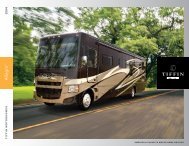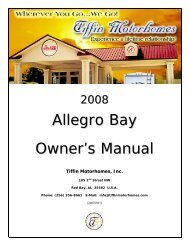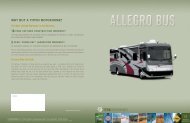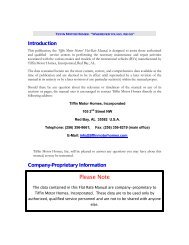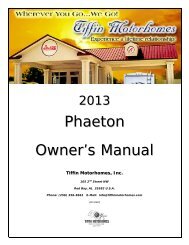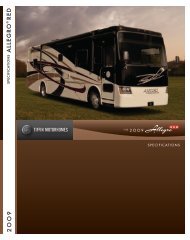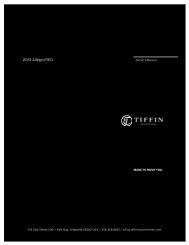2012 Phaeton Owner's Manual - Tiffin Motorhomes
2012 Phaeton Owner's Manual - Tiffin Motorhomes
2012 Phaeton Owner's Manual - Tiffin Motorhomes
Create successful ePaper yourself
Turn your PDF publications into a flip-book with our unique Google optimized e-Paper software.
DRIVING & SAFETY INSTRUCTIONSThese types of fire extinguishers are pressurized, mechanical devices and require that appropriate care be usedin their safe storage and use. The owner’s manual will provide necessary guidance for the proper storage,handling, and use of the extinguishers. Prudent preventive maintenance suggests monthly inspection of any fireextinguisher to assure that it is sufficiently pressurized (i.e., the needle on the gauge is in the “normal” zone) andthat the mechanical components are not blocked in any way.Do not test a fire extinguisher by partially discharging the unit—this will cause a loss of pressure and may lodgesome fire-retardant materials in the valve mechanism and cause the extinguisher to continue to vent slowlydown to zero pressure. Rather, if an extinguisher is ever partially used; continue its use until the unit iscompletely discharged then have the fire extinguisher fully recharged at an appropriate service center (one cancall any fire department for information on having an extinguisher recharged in that particular locality).DO NOT wait a long time to recharge an empty fire extinguisher; you’ll never know when it may be needed.Should a fire occur inside or around the motor home, evacuate the motor home quickly and calmly—do notpanic. In the event of heavy smoke or extensive flames, keep low (crawl if you must) and make your way to thenearest exit (door, emergency window) and leave. If the fire involves a fuel source (e.g., diesel fuel, LP gas);consider the probability of an explosion and move sufficiently far away to minimize personal harm. If such isavailable, immediately place a call to the local fire department (or ask someone nearby to do so) to report thefire. Consider the cause and the consequences of the fire and the risks associated with possibly fighting the fireyourself before trying to extinguish it—DO NOT expose yourself or others to unnecessary danger.Smoke DetectorThe <strong>Phaeton</strong> motor home is equipped with a battery-operated smoke detector (Figure 2-8) located on theceiling in the living area of the motor home. Read and become familiarwith the operation and periodic testing of this detector. The smokedetector should be tested on a weekly basis, before each trip, and afterany period of storage of the motor home.If a low-battery condition is noted or the alarm “chirps” to indicate alow-battery condition, immediately replace the battery. It would beFigure 2-8. Smoke Detectorprudent to keep replacement batteries in the motor home for any intransitreplacements so that the smoke-alarm capability is never compromised. DO NOT disable the smokedetector for any transient, false alarm (e.g., cooking smoke, dusty furnace, tobacco smoke); rather, ventilate themotor home with fresh air and the alarm will reset.Emergency Exit WindowIn the rear of the motor home, there is an emergency exitwindow (Figure 2-9) in the bedroom—this window is designedfor an emergency exit when it is not practical to exit by the door[also an emergency exit] in the front of the motor home. Thiswindow is readily noticeable by its red handle and the redFigure 2-9. Emergency Exit2-10



